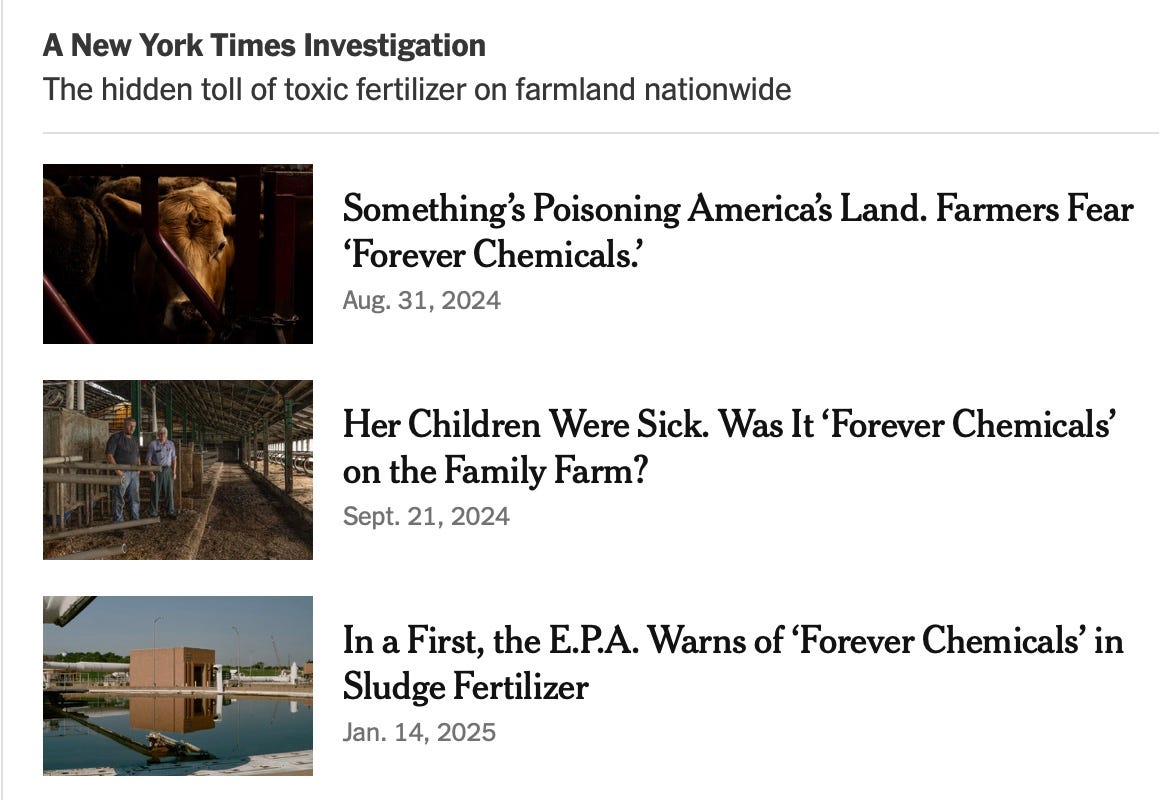SEWAGE SLUDGE: Can farms where it was spread be declared a Superfund site, asks South Carolina? Time to STOP the SPREAD of SLUDGE
The NYT estimated it has been spread on 20% of US farmland, encouraged by the EPA--and agency that seems as useful as the CDC and FDA during COVID
https://www.nytimes.com/2025/04/21/climate/sludge-fertilizer-farmland-superfund.html

… The use of industrial sewage as fertilizer broadens a crisis already affecting farmers nationwide.
Sludge from city sewage has been used as fertilizer for decades, a practice the federal government has long promoted. Last year, a New York Times investigation examined the widespread risks of PFAS contamination that resulted. And early this year, for the first time, the E.P.A. warned of the health risks of PFAS in fertilizer made from sewage sludge.
Factories far and wide, for example paper mills in Maine, have also provided wastewater sludge to farmers for years. Industrial wastewater has contamination risks that can go beyond city sewage….
The Galey & Lord mill shuttered a decade ago. The E.P.A. declared it a Superfund site in 2022, which triggered a federally-led cleanup of chemicals detected at the site including PCBs, arsenic, mercury and PFAS.
The yearslong cleanup could cost taxpayers millions of dollars, though there is also a mechanism to potentially force companies responsible for contamination to shoulder the costs. So far about 100,000 gallons of flammable liquid and other waste has been removed from the mill site.
It remains unclear how the Trump administration’s deregulatory agenda could affect Superfund cleanups. President Trump has declared the program, and clean air and water generally, a priority. Lee Zeldin, the E.P.A.’s administrator, recently toured toxic sites to talk about accelerating cleanups…
South Carolina is saying that the federal government should add the farmland to the mill’s Superfund designation, citing widespread contamination with PFAS, or per- and polyfluoroalkyl substances. These materials are known as “forever chemicals” because they don’t break down over time.
According to E.P.A. records, between 1993 and 2013 the Galey & Lord mill shipped more than 45,000 dry tons of sludge to more than 300 fields totaling roughly 10,000 acres. The median property is thought to have received 2.7 tons of sludge per acre, E.P.A. scientists said….
The sludge is rich in nutrients. And spreading it on fields cuts down on the need to incinerate it or put it in landfills. It also reduces the use of synthetic fertilizers made from fossil fuels.
But the sludge can be contaminated with pathogens as well as chemicals like PFAS, research has shown. Synthetic PFAS chemicals are widely used in everyday items like nonstick cookware and stain-resistant carpets, and are linked to a range of illnesses.
While the E.P.A. regulates some pathogens and heavy metals in sludge used as fertilizer, it does not regulate PFAS. In Maine, the only state to systematically test for PFAS on farmland, inspectors have found contamination on more than 100 dairy farms.
At least some of the land that South Carolina wants to be declared a Superfund site is currently used to grow food. Neither the E.P.A. nor South Carolina could say how much, or describe the potential risks…
In the groundwater at one field, levels of one type of the chemical, called perfluorooctanoic acid or PFOA, reached 1,500 times the E.P.A.’s safety standard for drinking water…
The New York Times reported last year that 3M, the chemical manufacturer, informed the E.P.A. in 2003 that its research had shown high concentrations of PFAS in wastewater sludge [which was ignored by EPA officials].
____________________________
A New York Times Investigation
The hidden toll of toxic fertilizer on farmland nationwide
Something’s Poisoning America’s Land. Farmers Fear ‘Forever Chemicals.’
Her Children Were Sick. Was It ‘Forever Chemicals’ on the Family Farm?
In a First, the E.P.A. Warns of ‘Forever Chemicals’ in Sludge Fertilizer
